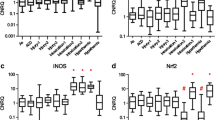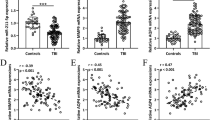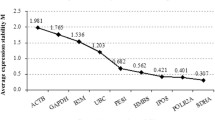Abstract
Methamphetamine (METH) is a highly addictive drug of abuse and toxic to the brain. Recent studies indicated that besides direct damage to dopamine and 5-HT terminals, neurotoxicity of METH may also result from its ability to modify the structure of blood-brain barrier (BBB). The present study investigated the postmortem brain mRNA and immunohistochemical expressions of matrix metalloproteases (MMPs), claudin5 (CLDN5), and aquaporins (AQPs) in forensic autopsy cases of carbon monoxide (n = 14), METH (n = 21), and phenobarbital (n = 17) intoxication, compared with mechanical asphyxia (n = 15), brain injury (n = 11), non-brain injury (n = 21), and sharp instrument injury (n = 15) cases. Relative mRNA quantification using Taqman real-time PCR assay demonstrated higher expression of AQP4 and MMP9, lower expression of CLDN5 in METH intoxication cases and lower expression of MMP2 in phenobarbital intoxication cases. Immunostaining results showed substantial interindividual variations in each group, showing no evident differences in distribution or intensity among all the causes of death. These findings suggest that METH may increase BBB permeability by altering CLDN5 and MMP9, and the self-protective system maybe activated to eliminate accumulating water from the extracellular space of the brain by up-regulating AQP4. Systematic analysis of gene expressions using real-time PCR may be a useful procedure in forensic death investigation.


Similar content being viewed by others
References
Halpin LE, Collins SA, Yamamoto BK (2013) Neurotoxicity of methamphetamine and 3,4-methylenedioxymethamphetamine. Life Sci
Martins T, Baptista S, Goncalves J, Leal E, Milhazes N, Borges F, Ribeiro CF, Quintela O, Lendoiro E, Lopez-Rivadulla M, Ambrosio AF, Silva AP (2011) Methamphetamine transiently increases the blood-brain barrier permeability in the hippocampus: role of tight junction proteins and matrix metalloproteinase-9. Brain Res 1411:28–40
Sharma HS, Kiyatkin EA (2009) Rapid morphological brain abnormalities during acute methamphetamine intoxication in the rat: an experimental study using light and electron microscopy. J Chem Neuroanat 37(1):18–32
Woessner JF Jr (1994) The family of matrix metalloproteinases. Ann N Y Acad Sci 732:11–21
Agrawal SM, Lau L, Yong VW (2008) MMPs in the central nervous system: where the good guys go bad. Semin Cell Dev Biol 19(1):42–51
Furuse M, Tsukita S (2006) Claudins in occluding junctions of humans and flies. Trends Cell Biol 16(4):181–188
Zador Z, Bloch O, Yao X, Manley GT (2007) Aquaporins: role in cerebral edema and brain water balance. Prog Brain Res 161:185–194
Wang Q, Ishikawa T, Michiue T, Zhu BL, Guan DW, Maeda H (2013) Molecular pathology of brain edema after severe burns in forensic autopsy cases with special regard to the importance of reference gene selection. Int J Legal Med 127(5):881–889
Wang Q, Ishikawa T, Michiue T, Zhu BL, Maeda H (2011) Evaluation of human brain damage in fire fatality by quantification of basic fibroblast growth factor (bFGF), glial fibrillary acidic protein (GFAP) and single-stranded DNA (ssDNA) immunoreactivities. Forensic Sci Int 211(1–3):19–26
Maeda H, Fukita K, Oritani S, Ishida K, Zhu BL (1997) Evaluation of post-mortem oxymetry with reference to the causes of death. Forensic Sci Int 87(3):201–210
Oritani S, Nagai K, Zhu BL, Maeda H (1996) Estimation of carboxyhemoglobin concentrations in thermo-coagulated blood on a CO-oximeter system: an experimental study. Forensic Sci Int 83(3):211–218
Tominaga M, Michiue T, Ishikawa T, Kawamoto O, Oritani S, Ikeda K, Ogawa M, Maeda H (2013) Postmortem analyses of drugs in pericardial fluid and bone marrow aspirate. J Anal Toxicol 37(7):423–429
Wang Q, Ishikawa T, Michiue T, Zhu BL, Guan DW, Maeda H (2012) Stability of endogenous reference genes in postmortem human brains for normalization of quantitative real-time PCR data: comprehensive evaluation using geNorm, NormFinder, and BestKeeper. Int J Legal Med 126(6):943–952
Zhao S, Fernald RD (2005) Comprehensive algorithm for quantitative real-time polymerase chain reaction. J Comput Biol 12(8):1047–1064
Hellemans J, Mortier G, De Paepe A, Speleman F, Vandesompele J (2007) qBase relative quantification framework and software for management and automated analysis of real-time quantitative PCR data. Genome Biol 8(2):R19
Livak KJ, Schmittgen TD (2001) Analysis of relative gene expression data using real-time quantitative PCR and the 2(-Delta Delta C(T)) Method. Methods 25(4):402–408
Huth A, Vennemann B, Fracasso T, Lutz-Bonengel S, Vennemann M (2013) Apparent versus true gene expression changes of three hypoxia-related genes in autopsy derived tissue and the importance of normalisation. Int J Legal Med 127(2):335–344
Wang Q, Ishikawa T, Michiue T, Zhu BL, Guan DW, Maeda H (2012) Quantitative immunohistochemical analysis of human brain basic fibroblast growth factor, glial fibrillary acidic protein and single-stranded DNA expressions following traumatic brain injury. Forensic Sci Int 221(1–3):142–151
Wang Q, Ishikawa T, Michiue T, Zhu BL, Guan DW, Maeda H (2012) Evaluation of human brain damage in fatalities due to extreme environmental temperature by quantification of basic fibroblast growth factor (bFGF), glial fibrillary acidic protein (GFAP), S100beta and single-stranded DNA (ssDNA) immunoreactivities. Forensic Sci Int 219(1–3):259–264
Hollander M, Wolfe DA (1999) Nonparametric statistical methods. Wiley series in probability and statistics Texts and references section, 2nd edn. Wiley, New York
Gibbons JD, Chakraborti S (2011) Nonparametric statistical inference. Statistics, textbooks & monographs, 5th edn. Taylor & Francis, Boca Raton
Madea B, Saukko P, Oliva A, Musshoff F (2010) Molecular pathology in forensic medicine-introduction. Forensic Sci Int 203(1–3):3–14
Maeda H, Ishikawa T, Michiue T (2011) Forensic biochemistry for functional investigation of death: concept and practical application. Leg Med (Tokyo) 13(2):55–67
Koppelkamm A, Vennemann B, Fracasso T, Lutz-Bonengel S, Schmidt U, Heinrich M (2010) Validation of adequate endogenous reference genes for the normalisation of qPCR gene expression data in human post mortem tissue. Int J Legal Med 124(5):371–380
Kimura A, Ishida Y, Hayashi T, Nosaka M, Kondo T (2011) Estimating time of death based on the biological clock. Int J Legal Med 125(3):385–391
Koppelkamm A, Vennemann B, Lutz-Bonengel S, Fracasso T, Vennemann M (2011) RNA integrity in post-mortem samples: influencing parameters and implications on RT-qPCR assays. Int J Legal Med 125(4):573–580
Chen JH, Michiue T, Ishikawa T, Maeda H (2012) Molecular pathology of natriuretic peptides in the myocardium with special regard to fatal intoxication, hypothermia, and hyperthermia. Int J Legal Med 126(5):747–756
Zhang H, Adwanikar H, Werb Z, Noble-Haeusslein LJ (2010) Matrix metalloproteinases and neurotrauma: evolving roles in injury and reparative processes. Neuroscientist 16(2):156–170
Liu Y, Brown S, Shaikh J, Fishback JA, Matsumoto RR (2008) Relationship between methamphetamine exposure and matrix metalloproteinase 9 expression. Neuroreport 19(14):1407–1409
Urrutia A, Rubio-Araiz A, Gutierrez-Lopez MD, ElAli A, Hermann DM, O’Shea E, Colado MI (2013) A study on the effect of JNK inhibitor, SP600125, on the disruption of blood-brain barrier induced by methamphetamine. Neurobiol Dis 50:49–58
Rosenberg GA, Estrada EY, Dencoff JE (1998) Matrix metalloproteinases and TIMPs are associated with blood-brain barrier opening after reperfusion in rat brain. Stroke 29(10):2189–2195
Svedin P, Hagberg H, Savman K, Zhu C, Mallard C (2007) Matrix metalloproteinase-9 gene knock-out protects the immature brain after cerebral hypoxia-ischemia. J Neurosci 27(7):1511–1518
Ramirez SH, Potula R, Fan S, Eidem T, Papugani A, Reichenbach N, Dykstra H, Weksler BB, Romero IA, Couraud PO, Persidsky Y (2009) Methamphetamine disrupts blood-brain barrier function by induction of oxidative stress in brain endothelial cells. J Cereb Blood Flow Metab 29(12):1933–1945
Tourdias T, Mori N, Dragonu I, Cassagno N, Boiziau C, Aussudre J, Brochet B, Moonen C, Petry KG, Dousset V (2011) Differential aquaporin 4 expression during edema build-up and resolution phases of brain inflammation. J Neuroinflammation 8:143
Fukuda AM, Pop V, Spagnoli D, Ashwal S, Obenaus A, Badaut J (2012) Delayed increase of astrocytic aquaporin 4 after juvenile traumatic brain injury: possible role in edema resolution? Neuroscience 222:366–378
Eugenin EA, Greco JM, Frases S, Nosanchuk JD, Martinez LR (2013) Methamphetamine alters blood brain barrier protein expression in mice, facilitating central nervous system infection by neurotropic Cryptococcus neoformans. J Infect Dis 208(4):699–704
Kast RE (2009) Use of FDA approved methamphetamine to allow adjunctive use of methylnaltrexone to mediate core anti-growth factor signaling effects in glioblastoma. J Neurooncol 94(2):163–167
Zhao D, Zhu BL, Ishikawa T, Quan L, Li DR, Maeda H (2006) Real-time RT-PCR quantitative assays and postmortem degradation profiles of erythropoietin, vascular endothelial growth factor and hypoxia-inducible factor 1 alpha mRNA transcripts in forensic autopsy materials. Leg Med (Tokyo) 8(2):132–136
Miyazato T, Ishikawa T, Michiue T, Maeda H (2012) Molecular pathology of pulmonary surfactants and cytokines in drowning compared with other asphyxiation and fatal hypothermia. Int J Legal Med 126(4):581–587
Acknowledgments
All practical work was performed at the Department of Legal Medicine Osaka City University.
This work was partially funded by Grants-in-Aid for Scientific Research from the Japan Society for the Promotion of Science and the Ministry of Education, Culture, Sports, Science and Technology, Japan (grant nos. 21790612 and 22590642).
Author information
Authors and Affiliations
Corresponding author
Electronic supplementary material
Below is the link to the electronic supplementary material.
ESM 1
(PPT 68 kb)
Rights and permissions
About this article
Cite this article
Wang, Q., Ishikawa, T., Michiue, T. et al. Molecular pathology of brain matrix metalloproteases, claudin5, and aquaporins in forensic autopsy cases with special regard to methamphetamine intoxication. Int J Legal Med 128, 469–474 (2014). https://doi.org/10.1007/s00414-014-0972-6
Received:
Accepted:
Published:
Issue Date:
DOI: https://doi.org/10.1007/s00414-014-0972-6




